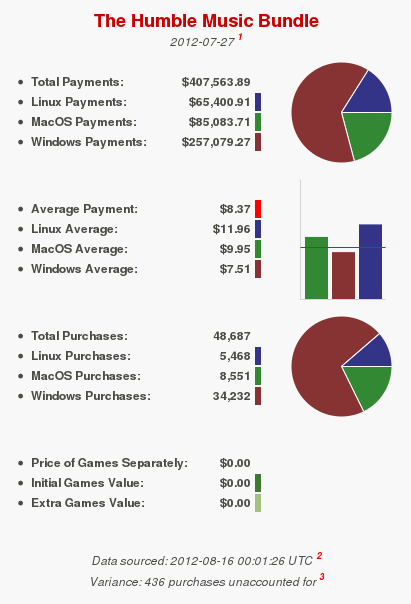
Recently, the Humble Bundle organisers surprised their community with a music-only promotion. Instead of the traditional arrangement of indie games and soundtracks, the Humble Music Bundle featured albums from OK Go, MC Frontalot, They Might Be Giants, Christopher Tin, Hitoshia Sakimoto and Jonathan Coulton - all of whom have some level of cult/geek appeal, which is likely to have significant overlap with the gamers that comprise the regular Humble Bundle's audience.
So, here's the thing. There are lots and lots of interpretations and theories regarding the disparity of platform averages. Most of the common ones I've seen revolve around the notion that Linux and MacOS users are "starved for games", or "have something to prove", suggesting that the Humble Bundle statistics are inherently unreliable or deceptive. Whilst I'm sure that these sorts of things almost certainly are a contributing factor, I've previously speculated that there are other factors at work.
Having a non-game related bundle to compare to has provided an opportunity to observe how Humble Bundle contributors behave in a context that isn't generally as platform dominant. There are exceptions though. Whilst one can imagine that MacOS users are more likely to be purchasing music via the iTunes Store, and Windows users might be the most likely people to be making use of the Zune Marketplace, the vast majority of existing digital music distribution platforms are web based and platform agnostic.
Additionally, the issue of DRM seems to be less prominent at this point in time in the music industry than in the gaming industry, so the Humble Music Bundle is likely to have had less specific appeal to DRM-free enthusiasts.
What we potentially have in front of us is a control sample of sorts (or at least the closest we can get at the moment), one which isn't skewed by Wine usage or a specific platform debut, by launch exclusivity conflicts or the inclusion of a hugely popular title, nor by reduced distribution methods or otherwise unobtainable soundtracks. Before we get into what that can tell us, let's take a look at what the numbers for this bundle look like.

The Humble Music bundle raised $407,562 worth of contributions, which is by far the lowest yet ($1,003,954.74 below the average total payments across all bundles of $1,411,516.74). It also drew in the smallest number of contributors, coming in at 48,687 (168,162 under the average total purchases across all bundles of 216,849). We can assume that one of the biggest factors in this is the simple fact that this type of Humble Bundle hadn't been tried before (the numbers for the Mojam event may be supportive of this assumption). This is fine and, on some levels, to be expected.
Looking at averages, the Humble Music Bundle managed a cross-platform average of $8.37, the fourth highest average of any Humble Bundle promotion to date ($1.86 above the average across all bundles of $6.51). In line with previous trends, Linux averages are characteristically higher at 42.89% above the cross platform average (with notable deviations during the Botanicula Debut and the first Android bundle), whilst the Windows average has stayed more or less steady with its usual position 10.27% below below the cross-platform average (a slight decline since the preceding two bundles). The MacOS deviation is higher than it has been since the Mojam event, but still within the bounds of established trends.
And here's where things start to get interesting. If we take a look at the platform based breakdown of contributors for the Humble Music Bundle (11.23% Linux, 17.57% MacOS and 70.31% Windows), we can immediately see a correlation against the per platform breakdown across all bundles (9.39% Linux, 13.69% MacOS and 75.38% Windows). Likewise there's similarity in the breakdown of contributions for the Humble Music Bundle (16.04% Linux, 20.88% MacOS and 63.08% Windows) and the breakdown across all bundles (16.17% Linux, 17.54% MacOS, 66.29% Windows). Why is this interesting? Because it suggests that these ratios are scalable.
Scalability becomes important when trying to understand and/or differentiate between "normal" behaviour and outlying anomalies. That our "control sample's" stats have near identical structure to our baseline derived from aggregating all the bundles together strongly indicates that these patterns are reliable and reproducible. That this correlation has occurred outside of any game-specific excitement massively undermines a lot of the dismissive arguments for strong/weak platform statistics. Whilst the value of these figures outside a pay-what-you-want model and without charity support is debatable, the numbers and balances that we're seeing here are legitimate and accurate representations of purchaser behaviour for the types of promotions that Humble Bundle run.

A note from Cheese
Thanks for reading!
If you're liked this article, you may also be interested in my shallow analysis of the first ten Humble Bundles. You might also be interested in reading an interview Reclaim Your Game did with me about my interpretations of Humble Bundle statistics.
If you want to see up to date graphs and statistics for other bundles, make sure to drop by the Humble Visualisations page.
If you've got any thoughts on this article, you can email me at cheese@twolofbees.com.
This article was published on the 16th of August 2012.